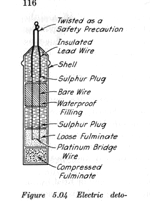Mining in Manitoba
Blasting Caps
Mining Systems
Nobel's original fuse-type blasting cap remained virtually unchanged for many years, except for the substitution of 90-10 and 80-20 mixtures of mercury fulminate and potassium chlorate for the pure fulminate. This did not affect the performance materially and provided a substantial economy. Mercury fulminate is an example of an explosive that can be both primary and secondary. In its more compressed form it is a high density base charge; less compressed, a low density primer charge. Hexanitromannitol (nitromannite) functions in the same manner and is used that way in a very successful blasting cap.
Extensive work was carried out on replacements for the costly mercury fulminate; by 1930 little of it remained in use, and by the 1970s it had disappeared from commercial use. Experience has shown that the cheaper replacements are actually superior.
The dominant base-charge materials are now pentaerythritol tetranitrate (PETN) and cyclotrimethylenetrinitramine (RDX). These are as strong as nitroglycerin, quite safe to manufacture and handle, and relatively inexpensive. In addition to low density nitromannite, diazodinitrophenol, lead styphnate, and lead azide are widely used as ignition-primer charges. One other departure from Nobel's blasting cap is the fact that aluminum has now almost entirely replaced copper as the material used for the shell.

Except for the means of firing, there is little difference between electric and fuse-type blasting caps. With minor variations, the explosives used are the same.
It was in the 1880s that the forerunner of the modern electric blasting cap was first assembled. In contrast to the spark-type ignitions previously used, it employed a fine, high-resistance wire soldered between two insulated leg wires and embedded in, or coated with, an ignition mixture. The resistance wire was either platinum or one of its alloys, and the ignition mixture was based on mercury fulminate. The leg wires were insulated with two layers of cotton thread, wound in opposite directions. Except for coal-mine caps, the wire was then run through a bath of molten asphalt. Paraffin wax was used for the coal-mine caps because its white colour provided good contrast with the black coal. Sulfur, or a mixture of sulfur and mica or graphite, was used to hold the leg wires in place and seal the cap. Sulfur was well suited for this purpose because its melting point is very low and it is compatible with the explosive ingredients. Later, to obtain better water resistance, part of the sulfur was replaced by asphalt.
In 1939 the du Pont company introduced a revolutionary new type of ignition system. Nylon plastic was substituted for the cotton insulation, a rubber plug to hold the leg wires replaced the sulfur plug, and the bridge wire was welded to the leg wires instead of soldered. By that time alloys such as nichrome had largely replaced the platinum bridge wires. The shell was crimped tightly to the rubber plug, with the result that the cap could withstand a substantial amount of water pressure. All electric blasting caps are now made substantially in this way. Polyvinyl chloride is widely used for the leg wire insulation, and plastic is sometimes substituted for rubber in the plug.
Match-head ignition, very popular in Europe, is used less widely in the United States. The ignition device consists of a piece of cardboard with a thin sheet of metal glued to each side. A bridge wire is soldered to these sheets, around the end of the cardboard, and this part of the assembly is dipped in a slurry of ignition mixture, usually based on copper acetylide. After drying, the match head is given a protective coating and is then soldered to the leg wires.
Most countries require explosives in underground coal mines to be fired electrically but prohibit the use of aluminum-shell electric blasting caps. This is because aluminum burns with a very hot flame and is much more likely than copper to ignite coal gas. Otherwise, almost all electric blasting-cap shells are made of aluminum.
Liquid Oxygen
ANFO
Nitrocellulosic
Nitroglycerin
Nitro Starch
Nitromon
Water Gels